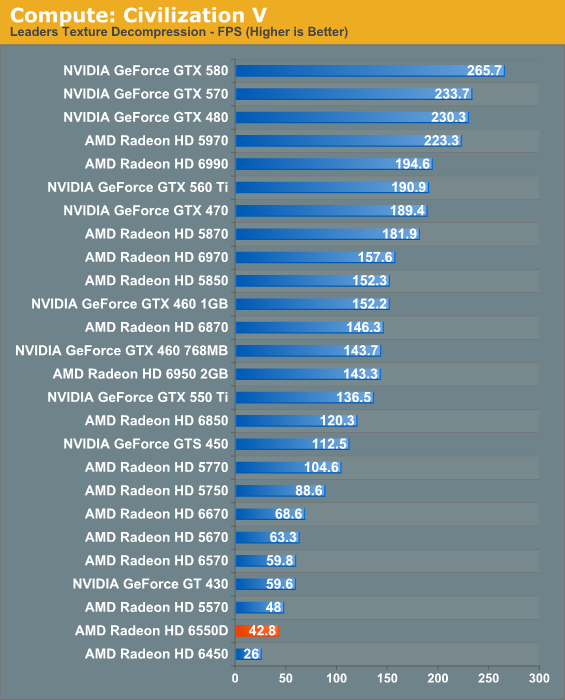The AMD A8-3850 Review: Llano on the Desktop
by Anand Lal Shimpi on June 30, 2011 3:11 AM ESTCompute & Video Transcoding Performance
AMD's hope with Fusion is that the GPU transistors will regularly be used for more than just 3D gaming. Today we're still hunting for good uses for GPU compute, but we do have a few benchmarks that we can use to illustrate Llano's GPU compute prowess.
Our compute benchmark comes from Civilization V, which uses DirectCompute to decompress textures on the fly. Civ V includes a sub-benchmark that exclusively tests the speed of their texture decompression algorithm by repeatedly decompressing the textures required for one of the game’s leader scenes. Note that this is a DX11 benchmark and obviously can't run on Intel's Sandy Bridge GPU.

The Radeon HD 6550D performs as expected - it offers performance close to the 5570 and above that of the 6450. Memory bandwidth constraints are less of an issue here apparently as the 6550D delivers 89% of the performance of the 5570.
One area where we can compare the Radeon HD 6550D and Intel's HD Graphics 3000 is in video transcoding performance. For that we turn to ArcSoft's MediaConverter 7 and measure performance transcoding a 15Mbps H.264 encoded 1080p Quantum of Solace rip to a 4Mbps 720p iPhone 4 compatible file:
| Video Transcoding Comparison | ||||
| AMD A8-3850 | Intel Core i3-2105 | |||
| Frames Transcoded per Second | 63.7 fps | 165.2 fps | ||
While the A8-3850 can exploit its GPU cores for transcoding, Intel's Quick Sync continues to be the faster method of transcoding video as we found in our original Sandy Bridge review.










99 Comments
View All Comments
evilspoons - Thursday, June 30, 2011 - link
Haha, I stupidly ordered a 1920x1200 panel in my work laptop (I really should've gone with 1680x1050).It's a 15".
Hahaha.
Alexvrb - Thursday, June 30, 2011 - link
You don't like your eyes very much, do you?misuspita - Thursday, June 30, 2011 - link
Oh come on, we come from the same place and that is not true. Budget systems come with the cheapest 19 LCD's which add 80€ to the price of a new budget PC. Resolution?1600x900.Yes, if you buy a second hand PC, then you get it with older monitors, but then, you don't get a brand new A8, right?
I also think that the resolutions tested should be max 3:
1. laptop minimum - 1366x768
2. LCD medium - 1600x900
3. LCD standard - 1920x1080
Musafir_86 - Thursday, June 30, 2011 - link
-Where are you from? I'm from Malaysia, and the place I mentioned is in context of a city (that's just a bit bigger than a town); in bigger cities the situation would be different, of course.-BTW, I meant a *NEW* budget system paired with a recond/refurbished monitors. CRT is offered to the most budget-constrained customers who would want a PC just for some word processing, surfing the internet, watching YouTube, and some light gaming for their kids. But more would prefer a LCD anyway, even if it's a refurb. :)
Regards.
misuspita - Thursday, June 30, 2011 - link
Sorry, your nickname is a word from romanian language, and I thought you are from Romania.Well, here new systems come with LCD's only, because they got really cheap in the past 5 years. And the cheaaaapest one still boasts a higher resolution than 1024x768. That's pretty ancient and not used anymore. Why do we not test in 640x480? I mean, safe mode works, we shoul test that one too...
L. - Thursday, June 30, 2011 - link
Again guys, we're reviewing new tech, the kind that costs a lot of money ... and stuff ..If you're into refurbished, I don't quite see the point of getting an i3 when you could get so much more out of second hand (pardon me, but in your position I'd rather spend 130 bucks on a full HD led-backlit LCD rather than a useless core i3).
ET - Thursday, June 30, 2011 - link
I'd argue for 1280x720 (720p) as the minimum resolution. That's a reasonable resolution to use as a step down on a 1080p monitor or HDTV.By the way, looking at Newegg, the lowest price monitors are either 1366x768 or 1440x900, then a couple of 1600x900 and then 1080p. The difference between in price between the cheapest 1600x900 and 1080p is $10.
Probably 1366x768 and 1080p are the only two resolutions really worth testing these days, since the market seems to be moving towards them as standards (much as I personally hate 16:9). Though I argued for 720p, the difference between it and 1366x768 is small.
BigDDesign - Friday, July 1, 2011 - link
1366x768 feels good with my eyesight and a 15" laptop. WTF is the problem with actually seeing what is on the screen at 2 feet away. 16:10 would be better, but we are stuck with cheap panels at 16:9. I wear glasses for the small stuff. Still don't think that a native resolution of anything less than a 24" monitor is good for 1080p resolution.stephenbrooks - Monday, July 4, 2011 - link
--[Still don't think that a native resolution of anything less than a 24" monitor is good for 1080p resolution.]--Yep, bought a 21.5" 1080p panel and it's pixels seem a little small for desktop use, suggesting 23-24" would be better. (Until all applications and OSes magically become resolution independent.)
zebrax2 - Thursday, June 30, 2011 - link
I disagree as many of lower end plasmas use 1024x768.